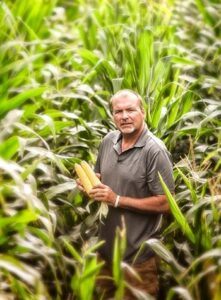Syngenta Has a Winning Roster of Fungicides
Syngenta goes all-in on disease control, adding Miravis fungicide to its 2019 lineup.

Year in and year out, professional athletic clubs spend millions of dollars looking for just the right talent to add to their lineups, fill skill gaps and win more games. Much like the athletic scouting process, Syngenta researchers are on a quest to find just the right tools to more effectively fight disease and, ultimately, help growers achieve higher returns. To that end, Syngenta has introduced two game-changing fungicide molecules for the row-crop market in the last three years—Solatenol® fungicide and most recently, Adepidyn® fungicide.
In laboratory and field tests, Solatenol and Adepidyn fungicides have proven to provide the best-of-the-best disease control and plant-health benefits of any fungicide available.
Not All SDHIs Are Created Equal
While both Solatenol and Adepidyn fungicides fit into the carboxamide chemical class with an SDHI (succinate dehydrogenase inhibitor) mode-of-action chemistry, they have their own characteristics that set them apart from each other—and every other fungicide on the market.
“In laboratory and field tests, Solatenol and Adepidyn fungicides have proven to provide the best-of-the-best disease control and plant-health benefits of any fungicide available,” says Eric Tedford, Ph.D., Syngenta fungicide technical product lead. “In 2019, Adepidyn will be available in multiple custom-designed fungicides under the Miravis® brand to combat geospecific disease threats that growers face.”
Row-Crop Diseases Meet Their Match
New and shifting disease patterns as well as resistance continue to drive the need for innovative technology.
“We’ve put together a robust row-crop fungicide portfolio to allow growers to choose the formulation that fits their specific disease problems,” says Brett Johnson, Syngenta fungicide product lead. Knowing the strengths of each brand will be crucial to selecting the best fungicide for 2019.”
The Syngenta row-crop fungicide portfolio will include the following brands:
Trivapro® fungicide—With first sales in 2016, Trivapro quickly proved its ability to work harder and last longer to fight diseases and help improve plant health for higher yields, versus untreated acres and competitive brands. Powered by three active ingredients—azoxystrobin, propiconazole and Solatenol fungicides—Trivapro has set a new standard for residual disease control for rusts, blights and leaf spots in corn, soybeans and wheat.
“Over the last few years, Trivapro’s consistently long residual control and yield bump have impressed my customers and me,” says William “Bill” Ruzicka with Farmers Feed & Grain in Riceville, Iowa. “In our side-by-side trials where other brands have petered out late in the season, Trivapro keeps protecting crops, which makes it worth the investment.”
One of his customers who has seen these benefits firsthand is grower Mark Forsyth from Charles City, Iowa. “I’ve been using Trivapro for three years now to control Northern corn leaf blight and gray leaf spot,” he says. “We started off with one field, and now we treat all our acres with Trivapro, because of the consistent stay-green effect and yield bump of 10 to 15 bushels per acre, sometimes more, depending on the hybrid.”
While Trivapro controls many diseases, efficacy ratings from university corn fungicide trials rank its Southern rust control as excellent—an important distinction for growers who face Southern rust pressure. Over the last few years, University of Kentucky Plant Pathologist Carl Bradley, Ph.D., has observed yield losses caused by Southern rust in Kentucky cornfields. “We really don’t have any corn hybrids with complete resistance to Southern rust, so application of an effective fungicide is really the only current method of management for this disease,” he says.

Miravis Neo fungicide—Similar to Trivapro, Miravis Neo will help corn and soybean producers combat disease by offering unmistakably superior control from three active ingredients: azoxystrobin, propiconazole and Adepidyn fungicides. Miravis Neo offers the most potent control of blights and leaf spots and will offer a new tool for white mold in soybeans.
Tedford notes that Miravis Neo has benefits beyond robust disease control. “In both lab and field tests evaluating crop stress responses, plants treated with Adepidyn have demonstrated more vigor,” he says. “That means under stressful conditions—like drought or heat stress, or even under light disease pressure—Miravis Neo–treated plants can put all their energy toward yield.”
Ruzicka, who had a chance to field-test the new technology this year, is looking forward to more widespread use of this exceptional product in 2019.
Miravis Top fungicide—Engineered specifically with Southern soybean growers in mind, Miravis Top contains difenoconazole and Adepidyn fungicides. With two powerful active ingredients, Miravis Top enables growers to control diseases—including susceptible and strobilurin-resistant frogeye leaf spot, target spot and Septoria brown spot—while providing the plant-health benefits they expect.
“Unlike some of the older chemistries growers have used before, both modes of action in Miravis Top will be working to protect their yield from disease,” says James Hadden, Ph.D., Syngenta fungicide technical product lead. “In our trials evaluating control of target spot, Septoria and strobilurin-resistant frogeye leaf spot, we’ve seen anywhere from a 3 to 5 bushel-per-acre yield increase with Miravis Top over competitive brands.”
In addition to outstanding disease control, Miravis Top will help alleviate the growing threat of disease resistance, Bradley says. “We all know about strobilurin-resistant strains of the frogeye leaf spot fungus,” he says, “and we have confirmed cases of strobilurin-resistant strains of the Septoria brown spot fungus. It’s really only a matter of time before we find and document strobilurin-resistant strains of the target spot fungus, too.”
Growers shouldn’t overlook the importance of having a new active ingredient to help combat growing resistance challenges, Bradley adds. Currently, control of frogeye leaf spot is coming from the triazole component of most fungicide products, since the fungus has exhibited widespread resistance to strobilurin fungicides. This is making the triazoles do all the “heavy lifting” and sets up a scenario where resistance to triazole fungicides could eventually develop as well. Using new chemistries from different chemical classes will help sustain management of frogeye leaf spot with fungicides for a longer period of time.

Miravis Ace fungicide—Wheat growers have long battled Fusarium head scab (blight) with relatively few modes of action and constrained application flexibility. In 2019, that situation will change with the introduction of Miravis Ace.
Containing Adepidyn and propiconazole, Miravis Ace will not only be the first SDHI-containing product available for Fusarium head scab control, but it will also be the first new mode of action for the disease in many years. Field tests across the country—from North Dakota to Pennsylvania and Kentucky—demonstrate that Miravis Ace will enable wheat growers to have more flexibility to treat all their acres at the right time for better, more predictable results.
In field tests, Syngenta has demonstrated that Miravis Ace can be sprayed as early as 50 percent head emergence, without sacrificing efficacy or yield. And because it delivers excellent control of Fusarium head scab, Miravis Ace can help reduce levels of the profit-robbing mycotoxin deoxynivalenol, also known as DON or vomitoxin.

A Tailor-Made Portfolio
With the introduction of the Miravis brands, row-crop growers now have four potent fungicides to choose from to fight the specific diseases that threaten their crops, Johnson notes.
“Unlike the repackaging and rebranding of old technology we’re seeing in some products, these brands contain game-changing molecules,” he says. “Solatenol already has completely changed row-crop disease control and plant-health protection as we know it, and Adepidyn will soon follow suit. Once growers try these products, they won’t go back.”
























